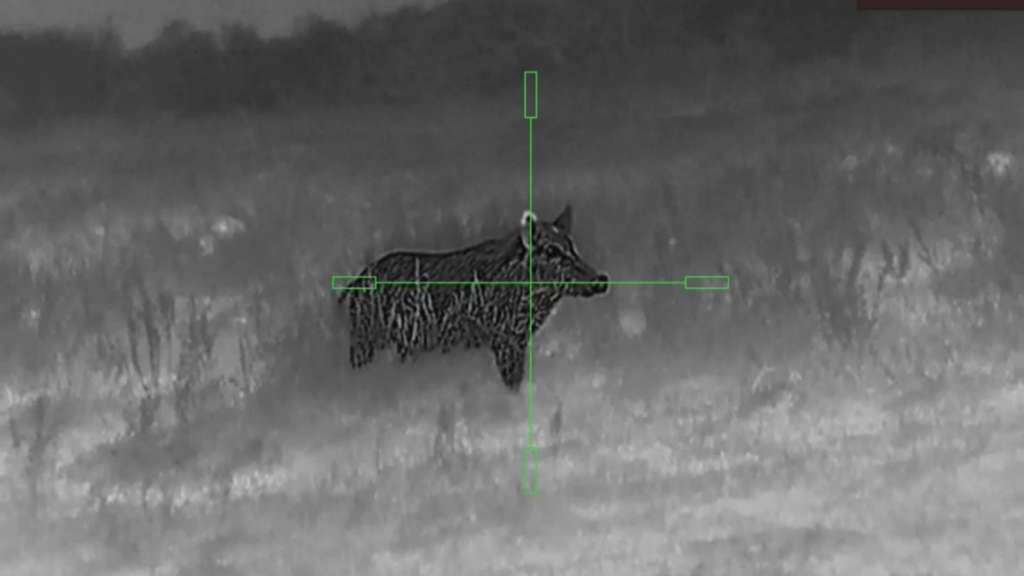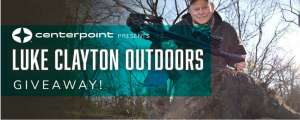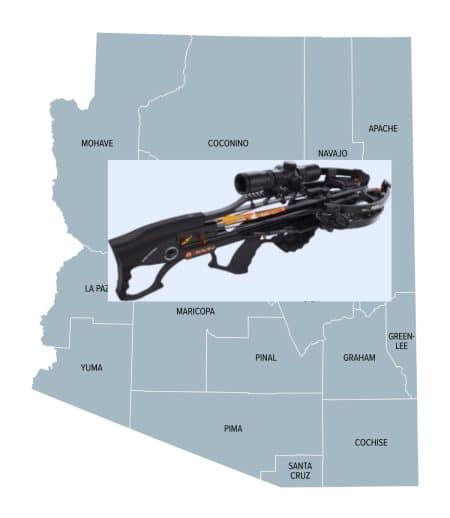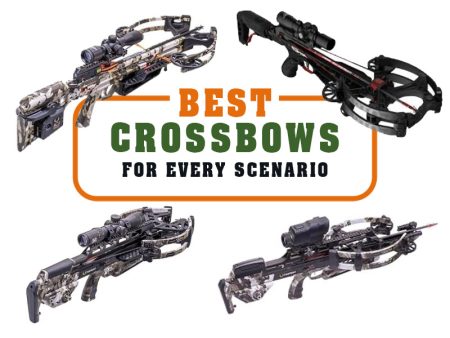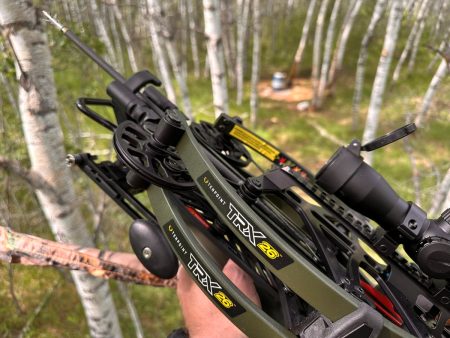Up Close, In The Dark
Hunting wild boar and predators with a crossbow at night is a surefire way of getting your adrenaline level peaked to the max.
When a toothy boar comes in so close you can smell him, there is zero room for error. You better not ruffle any leaves or make a sound; he will hear you and simply disappear like a ghost in the night. Luckily, hogs are often noisy critters, especially when coming into a corn feeder. It’s usually (but not always) possible to hear their approach.
Wild hogs get smarter as they become older. A wise old sow that has successfully raised several litters of pigs is as smart and wary as any critter in the woods. She has years of experience evading coyotes, bobcats and hunters. Mature boars are equally wary. They are reclusive animals and loners, using their noses continually to locate a receptive sow and to detect danger. They approach every situation cautiously and are always the last hog to come to a baited area. You might say they depend upon that keen nose to find food, to locate a mate, and to stay alive.
A wild boar is like a wary coyote, with a keen nose that will put a bloodhound’s sense of smell to shame. This skill gives them that uncanny ability to sense danger, making them even more challenging to hunt up close. Having the cover of darkness is a big plus on a hunt, regardless of whether your quarry is meat for the freezer or about predator control. Hunting with a crossbow also provides the challenge of needing to get close—much closer than you would if rifle hunting. When shooting from a good rest or shooting sticks, with the aid of good optics, crossbows are lethal weapons that might just be what you need to put the “spark” back into your time in the woods.
Methods
There are two basic methods of “lighting ‘em up” at night. You can use some sort of light with a red or green lens, or else a thermal or digital night-vision scope that mounts on your crossbow via a Picatinny rail. I’ve used both methods, and hands down, thermal is the best option for this kind of hunting, but it also comes with a much heftier price tag.
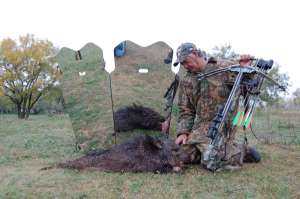
With thermal or digital night vision, it’s often possible to detect a hog coming to a feeder from a great distance away. Through the years, I’ve used lights with both red and green lenses and I’ve had success with both. I do believe the green lens to be a bit more effective. How a colored light is used often determines the outcome. Rather than placing the beam directly on the animal, it’s much better to use the beam’s outer edge. I begin by shining the light above where I expect the animal to be, then slowly lowering it until it’s possible to identify the target in the crosshairs.
Shining the full force of the beam directly at a hog or a predator at a relatively close range for a crossbow shot will probably spook the animal. It’s always best to adjust the light beam for wide-angle vision rather than using an intense beam, especially at shots inside 25 yards.
On occasion, I have made shots out to 40 yards at night where an intense beam was necessary. However, it was always begun by easing the beam onto the hog or predator. This gives the critter time to become familiar with the light and often keeps it calm and in place long enough to make the shot. Who knows what causes an animal to react? The same scenario might occur when clouds break and expose a full moon!
Take a Shooting Rest

Shooting sticks are worth their weight in gold when shooting a crossbow. Think about offhand shooting accuracy with a centerfire rifle. Groups tighten up significantly when shooting from a solid rest. In the field at night, it’s not always easy to find a solid rest unless hunting from a stand or ground blind. It takes only seconds to stabilize the crossbow with shooting sticks and locate the animal through the optics.
Think about the tight groups you shoot during the daylight hours with your crossbow at targets. With most bows, it’s necessary to either shoot at different spots on a target or pull the bolt after each shot. Not doing so often results in damaged bolts; crossbows are just that accurate.
Many crossbow shooters avoid shooting sticks because they are hunting with a “bow.” By design, crossbows and rifles have a few things in common. These include the ability to shoot from the shoulder and the ability to use an accurate aiming device. Deadly accuracy is a common outgrowth of both. Unless stalk hunting in really tight cover, I can think of only a few situations where the use of shooting sticks isn’t a huge benefit when hunting with a crossbow.
Using Thermal
When most folks think of purchasing a thermal scope, they think of shelling out several thousand dollars as the only option. Truthfully, on a crossbow, shots are probably going to be inside 40 yards at night and often half of that distance. That means there is no need for a high-end thermal scope, but the advantages of using thermal are myriad.
Since thermal identifies the heat signature of an approaching animal, it’s often possible to spot the approaching coyote, fox, or hog well before it gets within shooting range. Thermal scopes costing several thousand dollars are great for rifle hunting, where shots may be 200 or 300 yards out, but can be a bit of overkill for a crossbow hunter.
AGM Global Vision offers the Rattler in a model ideal for short-range (inside 100 yards) night hunting with a price tag of about $1,000. With a unit like this, animals on the darkest of nights can clearly be identified inside 75 yards. Larger animals, such as wild hogs, can be identified a bit farther away.
Digital night vision is another option for the night crossbow hunter, however, a good digital scope that works on IR costs almost as much as an entry-level thermal scope. Digital scopes work great when you are hunting in open country, but I believe they are nearly worthless when you’re navigating heavy cover. That’s because of the refraction off brush that lights up the viewfinder and obscures the target animal.
Get ‘Em In Close
Getting a wild hog or wary predators (such as coyotes or foxes) in close enough range for crossbow shots is challenging, but also very doable, if a few hunting basics are observed.
Obviously, there’s no need to worry about camo or concealment unless it’s a bright night with a full moon. Then, dark clothing is all that’s needed.
When using a call (either electric or mouth blown), make sure to call into the wind. Try to set up in areas with good visibility in front and heavy cover behind. Using this technique, you’ll have a good idea of the direction the critter will use to close the distance. You’ll need to be able to spot the approaching animal before it gets within shooting range, adjust your shooting sticks, and set up the crossbow for the shot.
Keep in mind, this must all be done very quietly to avoid alerting those super-sensitive ears. A bit of padding, such as pipe insulation glued to the mount of the shooting rest, can be very helpful. If using thermal, there’s no need to worry about spooking the animal with light. However, if you are using a bow-mounted light, remember to have it pointed up high before turning the beam on, and then slowly lower it to identify the target animal.
Night Sport/Stalk
Predators such as foxes, bobcats, or coyotes are next to impossible to stalk at night, regardless of which method you use to identify them (thermal, bow-mounted light, or digital night vision). But hogs are entirely stalkable. Slipping up on feeding hogs at night, armed with a crossbow, is one of the most exciting ways to hunt them. If you use a light, make sure the beam is illuminating the field of vision in front of the crossbow, rather than shining it off to one side. If it’s mounted on a rail built into the bow, you won’t have to worry about this, but check the alignment of the beam before your night hunt. Set the lens for a wide field of view rather than an intense beam.
I often hunt in pecan orchards at night as well as around corn feeders. The trick is to have everything ready before you approach a likely area. That includes a bolt with a broadhead on your bow and shooting sticks adjusted so you can make either a kneeling or standing shot. The height of brush or weeds will determine the height you need to set the sticks. This sounds pretty basic, but I have approached hogs at night with sticks set for a kneeling shot, only to be surrounded by brush.
Don’t think for a minute that wild hogs won’t pick up on the slightest sound, especially on a still night. You want to be ready to steady your bow, identify your target and make the shot quickly.
Night hunting is always exciting, and that’s especially so when you head into the darkness armed with a close-range weapon.
One last tip: always carry a compass and know the basic bearing back to a road, power line right-of-way or known landmark to get you back to the truck. There’s no need to worry about running a compass course at night in unfamiliar country, but knowing the general direction back to your vehicle will be very comforting after you’ve been following a blood trail and suddenly look up and wonder which way leads to the truck.
On a clear night, I always use the Big Dipper as a quick reference rather than continually looking at my compass. A good hunting app such as HuntStand is also very helpful. I use that app a lot, but a compass is most comforting on a pitch-black night!
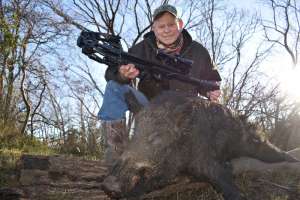
Per our affiliate disclosure, we may earn revenue from the products available on this page. To learn more about how we test gear, click here.

